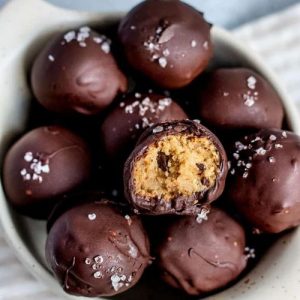
Chickpea Cookie Dough Bites
A quick, no-bake snack that’s rich in plant-based protein, fiber, and good fats. These Chickpea Cookie Dough Bites are coated in chocolate for a delicious, guilt-free treat perfect for snacking, dessert, or meal prep.
Equipment
- 1 food processor
- 1 mixing bowl
- 1 measuring cup
- 1 Measuring spoon
- 1 Cookie scoop or tablespoon
- 1 Parchment-lined tray
- 1 Microwave-safe bowl or small saucepan
- 2 Forks
Ingredients
- 1½ cups cooked chickpeas or 1 × 15 oz can, rinsed and drained
- ¼ cup peanut butter or cashew butter
- ¼ cup gluten-free oat flour
- 2 tbsp maple syrup
- 3 tbsp brown sugar
- ¼ tsp salt
- 1 tsp vanilla extract
- ⅓ cup vegan mini chocolate chips optional
- 1 × 4 oz bar vegan dark chocolate
Instructions
- Preparing the Chickpeas: Begin by rinsing your chickpeas thoroughly under cold running water to remove any canning liquid or residue. Place them in a clean kitchen towel or paper towel, and gently rub them between your hands to dry completely while removing loose skins. Removing excess moisture and skins helps create a smooth, cohesive cookie dough and avoids a bitter taste.
- Combining the Base Ingredients: Transfer the dried chickpeas to the bowl of a food processor. Add peanut butter or cashew butter, gluten-free oat flour, maple syrup, brown sugar, salt, and vanilla extract. Secure the lid and pulse on high speed until the mixture becomes a smooth dough. There should be no large chickpea chunks — instead, the dough should be slightly sticky and hold together well.
- Incorporating Chocolate Chips (Optional): If adding chocolate chips, fold them in now. Add them to the dough and pulse a few times just to incorporate them evenly. Avoid over-processing so the chips maintain their shape. This step gives the cookie dough extra texture and bursts of chocolate flavor without altering the dough’s smoothness.
- Chilling the Dough: Transfer the dough into a bowl, cover with plastic wrap or a towel, and refrigerate for about 15 minutes. Chilling helps the dough firm up, making it easier to handle. It also improves flavor as the ingredients meld together. This step is essential for shaping neat cookie dough bites.
- Shaping the Cookie Dough Balls: Line a tray with parchment paper to prevent sticking. Use a cookie scoop or tablespoon to portion out dough. Roll each portion between your palms until smooth and round, about the size of a large marble. Arrange each ball neatly on the prepared tray, spacing them slightly apart to avoid sticking.
- Firming in the Freezer: Place the tray of shaped cookie dough balls into the freezer for about 10 minutes. This step firms the dough, making it easier to coat in chocolate without losing shape. Freezing also helps the bites hold their structure while setting.
- Melting the Chocolate: Break the dark chocolate bar into small pieces and place in a microwave-safe bowl or a heatproof bowl for a double boiler. If microwaving, heat in 15-second intervals, stirring between each, until smooth and fully melted. If using a double boiler, stir continuously over low heat until melted. Allow the chocolate to cool slightly before dipping to avoid melting the dough.
- Coating the Cookie Dough Balls: Remove the tray from the freezer. Using two forks, dip each cookie dough ball into the melted chocolate until fully coated. Allow excess chocolate to drip off before placing the coated bite onto the parchment-lined tray. Work quickly but carefully to maintain an even coating.
- Setting the Chocolate: Place the coated cookie dough balls in the refrigerator for at least 10–15 minutes to allow the chocolate to firm completely. This creates a glossy, crisp chocolate shell that complements the soft dough inside.
- Serving and Enjoying: Once the chocolate has set, the bites are ready to enjoy. Store them in an airtight container in the refrigerator for up to a week or in the freezer for longer storage. These protein-packed, fiber-rich bites make a perfect snack, dessert, or on-the-go treat.
Notes
- Chill the dough before rolling to make shaping easier and maintain structure during chocolate coating.
- Freshly cooked chickpeas are recommended for a sweeter, cleaner taste, though canned chickpeas work for convenience.
- Rinse and dry canned chickpeas thoroughly to remove excess moisture and prevent a beany flavor.
- Adjust sweetness to your preference by changing the brown sugar first before adding extra maple syrup, which helps preserve dough texture.
- When substituting oat flour with almond flour, add a bit more flour to ensure the dough firms up properly.